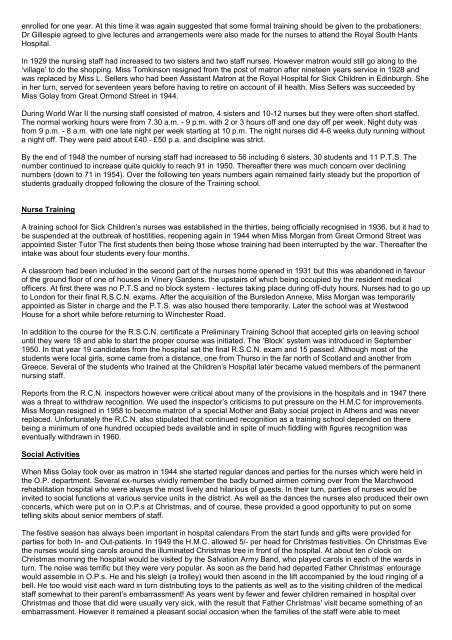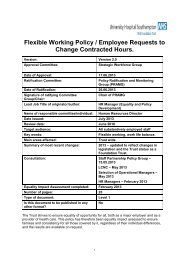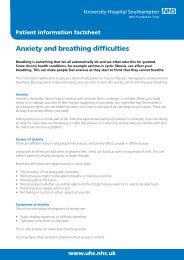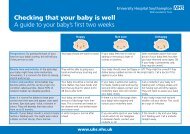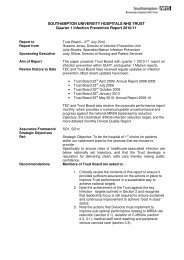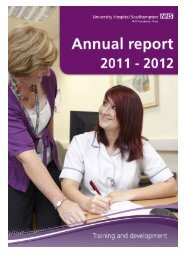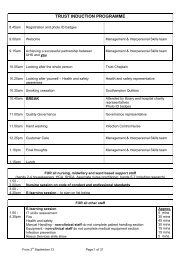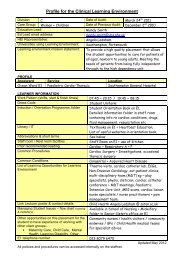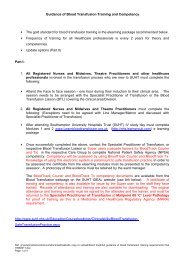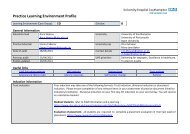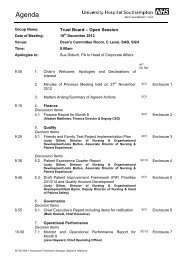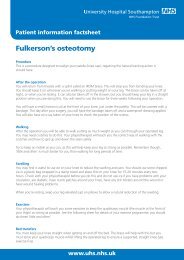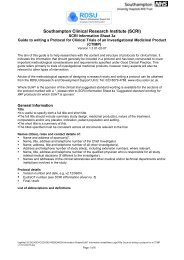ninety years of service - University Hospital Southampton NHS ...
ninety years of service - University Hospital Southampton NHS ...
ninety years of service - University Hospital Southampton NHS ...
- No tags were found...
Create successful ePaper yourself
Turn your PDF publications into a flip-book with our unique Google optimized e-Paper software.
enrolled for one year. At this time it was again suggested that some formal training should be given to the probationers;Dr Gillespie agreed to give lectures and arrangements were also made for the nurses to attend the Royal South Hants<strong>Hospital</strong>.In 1929 the nursing staff had increased to two sisters and two staff nurses. However matron would still go along to the‘village’ to do the shopping. Miss Tomkinson resigned from the post <strong>of</strong> matron after nineteen <strong>years</strong> <strong>service</strong> in 1928 andwas replaced by Miss L. Sellers who had been Assistant Matron at the Royal <strong>Hospital</strong> for Sick Children in Edinburgh. Shein her turn, served for seventeen <strong>years</strong> before having to retire on account <strong>of</strong> ill health. Miss Sellers was succeeded byMiss Golay from Great Ormond Street in 1944.During World War II the nursing staff consisted <strong>of</strong> matron, 4 sisters and 10-12 nurses but they were <strong>of</strong>ten short staffed.The normal working hours were from 7.30 a.m. - 9 p.m. with 2 or 3 hours <strong>of</strong>f and one day <strong>of</strong>f per week. Night duty wasfrom 9 p.m. - 8 a.m. with one late night per week starting at 10 p.m. The night nurses did 4-6 weeks duty running withouta night <strong>of</strong>f. They were paid about £40 - £50 p.a. and discipline was strict.By the end <strong>of</strong> 1948 the number <strong>of</strong> nursing staff had increased to 56 including 6 sisters, 30 students and 11 P.T.S. Thenumber continued to increase quite quickly to reach 91 in 1950. Thereafter there was much concern over decliningnumbers (down to 71 in 1954). Over the following ten <strong>years</strong> numbers again remained fairly steady but the proportion <strong>of</strong>students gradually dropped following the closure <strong>of</strong> the Training school.Nurse TrainingA training school for Sick Children’s nurses was established in the thirties, being <strong>of</strong>ficially recognised in 1936, but it had tobe suspended at the outbreak <strong>of</strong> hostilities, reopening again in 1944 when Miss Morgan from Great Ormond Street wasappointed Sister Tutor The first students then being those whose training had been interrupted by the war. Thereafter theintake was about four students every four months.A classroom had been included in the second part <strong>of</strong> the nurses home opened in 1931 but this was abandoned in favour<strong>of</strong> the ground floor <strong>of</strong> one <strong>of</strong> houses in Vinery Gardens. the upstairs <strong>of</strong> which being occupied by the resident medical<strong>of</strong>ficers. At first there was no P.T.S and no block system - lectures taking place during <strong>of</strong>f-duty hours. Nurses had to go upto London for their final R.S.C.N. exams. After the acquisition <strong>of</strong> the Bursledon Annexe, Miss Morgan was temporarilyappointed as Sister in charge and the P.T.S. was also housed there temporarily. Later the school was at WestwoodHouse for a short while before returning to Winchester Road.In addition to the course for the R.S.C.N. certificate a Preliminary Training School that accepted girls on leaving schooluntil they were 18 and able to start the proper course was initiated. The ‘Block’ system was introduced in September1950. In that year 19 candidates from the hospital sat the final R.S.C.N. exam and 15 passed. Although most <strong>of</strong> thestudents were local girls, some came from a distance, one from Thurso in the far north <strong>of</strong> Scotland and another fromGreece. Several <strong>of</strong> the students who trained at the Children’s <strong>Hospital</strong> later became valued members <strong>of</strong> the permanentnursing staff.Reports from the R.C.N. inspectors however were critical about many <strong>of</strong> the provisions in the hospitals and in 1947 therewas a threat to withdraw recognition. We used the inspector’s criticisms to put pressure on the H.M.C for improvements.Miss Morgan resigned in 1958 to become matron <strong>of</strong> a special Mother and Baby social project in Athens and was neverreplaced. Unfortunately the R.C.N. also stipulated that continued recognition as a training school depended on therebeing a minimum <strong>of</strong> one hundred occupied beds available and in spite <strong>of</strong> much fiddling with figures recognition waseventually withdrawn in 1960.Social ActivitiesWhen Miss Golay took over as matron in 1944 she started regular dances and parties for the nurses which were held inthe O.P. department. Several ex-nurses vividly remember the badly burned airmen coming over from the Marchwoodrehabilitation hospital who were always the most lively and hilarious <strong>of</strong> guests. In their turn, parties <strong>of</strong> nurses would beinvited to social functions at various <strong>service</strong> units in the district. As well as the dances the nurses also produced their ownconcerts, which were put on in O.P.s at Christmas, and <strong>of</strong> course, these provided a good opportunity to put on sometelling skits about senior members <strong>of</strong> staff.The festive season has always been important in hospital calendars From the start funds and gifts were provided forparties for both In- and Out-patients. In 1949 the H.M.C. allowed 5/- per head for Christmas festivities. On Christmas Evethe nurses would sing carols around the illuminated Christmas tree in front <strong>of</strong> the hospital. At about ten o’clock onChristmas morning the hospital would be visited by the Salvation Army Band, who played carols in each <strong>of</strong> the wards inturn. The noise was terrific but they were very popular. As soon as the band had departed Father Christmas’ entouragewould assemble in O.P.s. He and his sleigh (a trolley) would then ascend in the lift accompanied by the loud ringing <strong>of</strong> abell. He too would visit each ward in turn distributing toys to the patients as well as to the visiting children <strong>of</strong> the medicalstaff somewhat to their parent’s embarrassment! As <strong>years</strong> went by fewer and fewer children remained in hospital overChristmas and those that did were usually very sick, with the result that Father Christmas’ visit became something <strong>of</strong> anembarrassment. However it remained a pleasant social occasion when the families <strong>of</strong> the staff were able to meet


